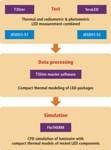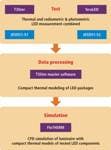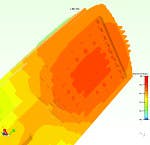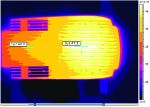This article was published in the July/August 2012 issue of LEDs Magazine.
View the Table of Contents and download the PDF file of the complete July/August 2012 issue, or view the E-zine version in your browser.
+++++
Solid-state lighting (SSL) designers who consider thermal properties in their LED based design are more likely to produce luminaires with long-term consistent light output and longer lifetime. In addition, in the case of LED street lights, illumination often needs to be consistent over a range of ambient conditions, which can be assured using the appropriate simulation and thermal testing techniques.
This article demonstrates how thermal simulation using computational flow dynamics (CFD), and thermal testing to the latest Joint Electron Devices Engineering Council (JEDEC) standards, can provide the luminous flux of a street-light luminaire under various conditions. The test methods shown can be used in prototype development, product testing or failure analysis of luminaires.
What constitutes good thermal design?
LEDs, as one of the most efficient light sources available today, are becoming more widely used in indoor lighting, outdoor lighting and automotive lighting. Good thermal design based on the application is essential to ensuring the longevity of the LED luminaire because both LED lifetime and light output are closely related to the LED’s junction temperature.
As of today, diligent lighting design with LEDs cannot be based solely on a manufacturer’s data-sheet values. Information needs to be gathered experimentally by physical testing of LEDs, and the gathered LED characteristics need to be provided for thermal simulation using, for instance, CFD.
Thermal characterization of LEDs
From a semiconductor standpoint, LEDs are simple pn-junctions, thus it seems that they should be easier to measure, when in actuality they are not. LEDs present a number of thermal characterization challenges. They are often very small, and measuring them un-mounted is difficult. Fortunately, parts can be mounted on two different substrates and the dual-interface measurement principle can be applied for obtaining their junction-to-case thermal resistance. A greater challenge comes from the fact that LEDs, unlike other semiconductors, emit light.
Light emission must be considered when measuring the LED’s thermal resistance. For the majority of semiconductor devices, thermal resistance can be calculated by simply dividing the temperature rise by the electrical power applied to the package. This is because all of the supplied electrical power is converted to heat. However, this is not the case for LEDs because a significant proportion of the supplied energy is converted into and emitted as light, making it an efficient light source. Depending on the LED, energy conversion efficiency can be as high as 30-40%.
In this system, the temperature of the LED under test can be precisely set to a desired value by a temperature-controlled cold plate. Such a measurement setup is also suggested by one of the most recent LED thermal testing standards, JESD51-52, which provide guidelines on methods to measure LED light output in connection with LED thermal measurements. This standard is one of a group of four new international thermal test standards for LEDs that were published in May 2012.
As for the thermal characteristics of LED components, the junction-to-case resistance is the most appropriate metric for packaged LEDs because it characterizes the heat flow path from the point of heat generation at the pn-junction down to the bottom of the case – exactly how LED packages are designed to be cooled. A relatively new standard, JEDEC JESD51-14, for junction-to-case thermal resistance measurement, is based on the latest thermal-transient measurement techniques.
This method uses a dual-interface approach in which the thermal resistance of the part is measured against a cold plate with and without thermal grease. The junction-to-case resistance is determined by examining where the two measurements differ. Very high measurement repeatability is required because the thermal impedance curves for the two measurements must be identical up to the point where the heat starts to leave the package and enter the thermal interface between the package and the cold plate. This ensures that the point where the curves deviate is clear. It compares to LEDs mounted on a cold plate attached to an integrating sphere (as the JESD51-52 standard recommends). This method provides the real junction-to-case thermal resistance metric for LED packages if during the two subsequent measurements the cold plate with LED under test is attached to an integrating sphere (as the new JESD51-52 standard recommends).
Solutions for LED thermal characterization
The Mentor Graphics T3Ster thermal transient tester uses a smart implementation of the static test version of the JEDEC JESD51-1 electrical test method that allows for continuous measurement during a heating or cooling transient, which also forms the basis of the JESD51-14 test method for the junction-to-case thermal resistance measurements. This is also the preferred test method in the LED-specific thermal measurement guidelines that are provided in the JESD51-51 standard. The combination of Mentor Graphics’ T3Ster and TeraLED products provide a comprehensive solution for LED testing which meets the requirements of all the mentioned standards (Fig. 1).
The T3Ster Master post-processing software fully supports the JESD51-14 standard for junction-to-case thermal resistance measurement, allowing the temperature versus time curve obtained directly from the measurement to be re-cast as “structure functions” (described in JESD51-14 Annex A), and then automatically determine the junction-to-case thermal resistance value. Structure functions are also widely used in failure analysis as part of reliability studies mentioned earlier. This combined with LM-80-compliant lifetime tests of LEDs helps establish correlation between LED lifetime and degradation of different thermal interfaces in the junction-to-ambient heat-flow path of LED components (see mycite.omikk.bme.hu/doc/102602.pdf).
Because the JESD51-14 methodology yields the junction-to-case thermal resistance as a side product, the step-wise approximation of the structure function up to this thermal resistance value provides the dynamic compact thermal model of the LED package automatically. The identified junction-to-case thermal resistance values may be published on the product datasheet, and the automatically generated dynamic compact thermal model of the LED package can be applied directly in CFD analysis software such as Mentor Graphics FloTHERM.
The challenge of correct LED thermal characterization is compounded because an LED’s efficiency is adversely affected by the junction temperature. This presents a challenge for both LED vendors and SSL designers. The LED’s light output, junction temperature, and power draw need to stabilize before measurements can be taken. Consequently, the static measurement method used to capture the cooling curve is the only correct approach to characterize LEDs.
The combination of the light output measurement (performed with equipment such as TeraLED), and thermal transient testing allows measurement of the light-output characteristics as a function of the temperature. Providing these data as a function of the reference temperature of the cold plate is useful information for SSL designers. But the same data is also available as a function of the LEDs’ junction temperature, which is required for the correct physical modeling of the light output of LEDs, in other words, the input data for hot lumen calculations. Such a combined thermal and radiometric/photometric test setup is recommended by the most recently published JESD51-5x series of LED thermal testing standards.
Street-light luminaires
Hungary, was to develop street-lighting luminaires with the minimal number of LEDs per luminaire such that all requirements of the rather strict European street-lighting standards could be met for a wide range of road categories. The two principal goals to reach were to obtain the required spatial light distribution pattern (batwing pattern) and to reach the required level of luminance on the road surface under all possible environmental conditions.
Careful thermal design is required to achieve the second goal because the required level of light output must also be ensured on a hot summer evening. For this, reliable thermal simulations are needed that properly predict the junction temperatures of LEDs assembled into the luminaire. Unfortunately, luminaire vendors have not yet published LED thermal models. Thermal data on their data sheet are sometimes questionable because, so far, no testing standard has been explicit about the combined thermal and radiometric/photometric testing of LEDs to be able to yield the real thermal metrics of LEDs. The solution to the thermal design problem of HungaroLux was provided by the combination of Mentor Graphics thermal testing and CFD analysis tools.
As described in the previous section, thermal testing of LEDs can yield compact thermal models of their packages that are directly applicable in CFD simulation tools. The CAD file of the HungaroLux street-lighting luminaire (Fig. 2) was also directly used to build the final, detailed system-level thermal model. All 48 LEDs were replaced by their compact models along with a compact thermal model of the LED driver circuitry.
From the dissipation of the individual LEDs driven by the nominal forward current (350 mA, 700 mA, 1500 mA), the driver’s dissipation is also calculated. In this way, the luminaire-level CFD analysis is performed with real data that represent the LEDs’ junction temperatures (Fig. 3). The CFD thermal simulation results have been verified by measuring the surface temperature of the luminaire (Fig. 4).
Because the temperature dependence of the light output characteristics of the LEDs was known from the same measurements that formed the basis of the LEDs’ compact thermal models, the total luminous flux output of the luminaire also could be calculated. Using this method, the luminaire could be properly sized in terms of the number of LEDs needed to provide the required road luminance level and for the LEDs’ junction temperature.
Conclusions
Recently published LED thermal testing standards and their commercial implementations provide tools for comprehensive physical testing of power LED components. Measurement results can be easily turned into LED compact models that are directly applicable in CFD-based thermal analysis on the luminaire level. The system-level CFD simulation results also allow the calculation of the hot lumens of the entire luminaire because the combined thermal and radiometric/photometric test setup used in the physical characterization of LEDs yields data regarding the temperature dependence of the total luminous flux of LEDs. With such a diligent and comprehensive characterization method, SSL designers can be assured that their final LED-based products will meet the applicable lighting standards and will provide the expected long lifetime.









